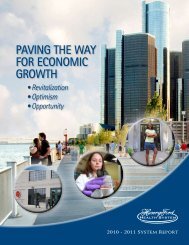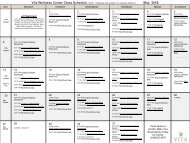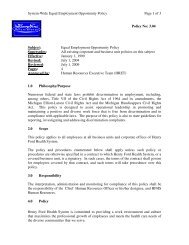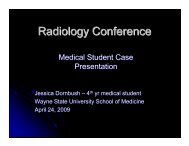gemba walk for leaders to sustain lean progress and develop people
gemba walk for leaders to sustain lean progress and develop people
gemba walk for leaders to sustain lean progress and develop people
You also want an ePaper? Increase the reach of your titles
YUMPU automatically turns print PDFs into web optimized ePapers that Google loves.
Is there any backtracking, rework, looping around? Are things where they are actually needed? Do <strong>people</strong> have <strong>to</strong>look around <strong>for</strong> things?How do they know what they should be doing? What is their source of in<strong>for</strong>mation? Do they have <strong>to</strong> hunt it down,or worse, guess at what should be done? Or is the “right thing” <strong>and</strong> the “right way” chrystal clear <strong>to</strong> even the casualobserver (that would be you).Is there a pace <strong>to</strong> the work? Even if it isn’t traditional takt‐time work (especially if it isn’t), there is some kind ofdeadline. How does the person know whether things are on time or not? When do they learn they are behind?If the person encounters some kind of problem, something unexpected, something needed but not there, whathappens? Is there a support system <strong>to</strong> get this person back on‐process? Or is he or she left <strong>to</strong> their own devices <strong>to</strong>just figure it out?As you watch, keep your st<strong>and</strong>ard very high. If something is not obviously as it should be, then question whether it is.“Control” has the burden of proof here, not chaos.When you see these things, focus in on one of them. Ask yourself “Why?” does this condition exist? Where does theproblem originate? Go there. Study some more. How is it that this process fails <strong>to</strong> support its cus<strong>to</strong>mer? Do theyhave a clear underst<strong>and</strong>ing of what is expected? (Probably not, most don’t, especially administrative processes.)How do they know they delivered (or didn’t) what their cus<strong>to</strong>mer required? Did they think their output was defectfree (according <strong>to</strong> their st<strong>and</strong>ards), but was really causing problems <strong>for</strong> their cus<strong>to</strong>mer?Often it helps <strong>to</strong> look at one person doing a single task, find a single issue, <strong>and</strong> follow the trap line upstream untilyou arrive at the origin of the problem. Often, again, you will have a fixable root cause right in front of you.Now the fun begins. As a leader, it is not your job <strong>to</strong> fix the problem. That is not what you are looking <strong>for</strong>.When you <strong>walk</strong> the <strong>gemba</strong>, you are assessing how well your organization is tuned <strong>to</strong> seeing these issues, clearingthem, finding their causes, <strong>and</strong> solving them. If you see these opportunities, then your job now is <strong>to</strong> teach.Grab whoever it is whose responsibility bounds both the effect <strong>and</strong> the origin of the problem. Guide him throughthe same things. If this issue was unaddressed, there are a couple of problems this leader must address.First, there is someone downstream likely coping with an issue that he should be raising. (Or worse, there is noprocess <strong>for</strong> raising the issue, or worse still, no process <strong>to</strong> respond if he does.) If that isn’t happening, help this leaderunderst<strong>and</strong> that this is the shortfall here, not the actual issue. It is now his turn <strong>to</strong> teach, in turn, either the TeamMember, or whatever leader is between him <strong>and</strong> the Team Member.Second, upstream, there is a process which either does not underst<strong>and</strong> what “defect free” is, or does not have (ordoes not use) a positive way <strong>to</strong> verify it be<strong>for</strong>e sending it along. Same issue. This is a leader training process until theeducation reaches the level that should be doing the checks <strong>and</strong> the verifications.The best way <strong>to</strong> learn how <strong>to</strong> do this is <strong>to</strong> <strong>walk</strong> your flow with someone who has the skill. It is simply a skill, <strong>and</strong> itcan be taught. But learning also requires some humility, <strong>and</strong> the student must bring that <strong>to</strong> the “classroom.”So, <strong>to</strong> recap in two short statements.The <strong>gemba</strong> <strong>walk</strong> is a “Check” of Plan‐Do‐Check‐Act.You are checking the health of your <strong>leaders</strong>hip systems by looking at how they engage their <strong>people</strong> <strong>and</strong>processes.Walking the <strong>gemba</strong> is a process of <strong>develop</strong>ing your <strong>people</strong>.+++++++++++++++++++++++++++++++++++++++++++++++++++++++++++++++++++++++++++++++++++++++++++++++The following further reflections on Gemba Walk are from Mike Mogharei in his blog Lean Tools Spotlights. Notehis suggestions <strong>and</strong> speak refect the manufacturing Gemba but many of the suggestions directly translate <strong>to</strong> ourworkplace, e.g. substitute Work‐in‐Process <strong>to</strong> backlogs of patients, specimens, charts, billing invoices,credentialling packets, etc.An effective “Lean Tool” practiced by many organizations who are pursuing continuous improvement <strong>and</strong>per<strong>for</strong>mance excellence is the modern practice of “Gemba Walk”, which many confused with the classicalmanagement style of MBWA (Management By Walking Around). The purpose of the MBWA exercise is <strong>to</strong> show that
you are genuinely interested in employees <strong>and</strong> their work <strong>and</strong> are out on the floor listening <strong>to</strong> suggestions <strong>and</strong>concerns, while Gemba Walk is designed <strong>to</strong> allow <strong>leaders</strong> <strong>to</strong> identify existing safety hazards, observe machinery <strong>and</strong>equipment conditions, ask about the practiced st<strong>and</strong>ards, gain knowledge about the work status <strong>and</strong> buildrelationships with employees.The word “Gemba” is a Japanese term meaning the real place where value is created <strong>and</strong> the actual work is done, i.e.the shop floor in a manufacturing plant, <strong>and</strong> the aim of Gemba Walk is <strong>to</strong> provide a leader with the opportunity <strong>to</strong>observe floor activities as they happen <strong>and</strong> ask questions about them, thus becoming more aware of what is goingon in the organization. As part of the Kaizen philosophy, managers are encouraged <strong>to</strong> “Go, See, <strong>and</strong> Observe”(Genchi Genbutsu) the work processes <strong>for</strong> themselves at Gemba in order <strong>to</strong> gain a better underst<strong>and</strong>ing of theiroperations. Masaaki Imai, a Lean guru, in his book titled “Gemba Kaizen: A Commonsense Low‐cost Approach <strong>to</strong>Management,” states “The worst thing a manager can do is live in a world isolated from Gemba.”When doing the Gemba Walk, you should look <strong>for</strong> answers <strong>to</strong> the following questions:1. Is the working environment safe <strong>and</strong> Lean? Is the 5S system in place being <strong>sustain</strong>ed?2. Is there a Visual Management System in place? Are the problems visible?3. Are the required in<strong>for</strong>mation, measures, <strong>and</strong> metrics displayed <strong>and</strong> updated? Are there any St<strong>and</strong>ardizedWork Sheets (SWS) posted?4. Could you easily identify the state of <strong>progress</strong>? Is the work ahead or behind schedule? Is there an efficientlevel of Work‐In‐Process (WIP) <strong>and</strong> Finished‐Goods (FG) materials available?5. How are the products <strong>and</strong> processes <strong>develop</strong>ed? What fulfillment systems are in place from order <strong>to</strong>delivery?6. Is the machinery <strong>and</strong> equipment running <strong>and</strong> in good condition? Do you see any leakage or damage? Do youhear any abnormal noise?Gemba Walk will also provide the opportunity <strong>to</strong> build stronger relationships with team members through engagingthem in conversation about the work processes <strong>and</strong> praising them <strong>for</strong> jobs well done. This will create a better senseof ownership in team members, due <strong>to</strong> their being asked about their underst<strong>and</strong>ing of the work st<strong>and</strong>ards <strong>and</strong> howthose could be improved upon <strong>and</strong> made more efficient.As can be seen, Gemba Walk is an important Lean <strong>to</strong>ol that should be used routinely <strong>to</strong> help you become aware ofany existing abnormalities, immediately deal with hazardous <strong>and</strong> unsafe conditions, verify established st<strong>and</strong>ardizedprocesses, solve problems or correct errors <strong>and</strong> create a more efficient <strong>and</strong> effective working environment <strong>and</strong>work<strong>for</strong>ce.+++++++++++++++++++++++++++++++++++++++++++++++++++++++++++++++++++++++++++++++++++++++++++++++Lastly, let me share the following from the consultant ProductivityInc from their blog The LEANing Post.Five Things <strong>to</strong> Consider on a Gemba WalkThe Gemba Walk is all about getting out in<strong>to</strong> the workplace. It af<strong>for</strong>ds company <strong>leaders</strong>, managers <strong>and</strong> supervisorsa reliable, simple <strong>and</strong> easy means of supporting an improvement structure <strong>and</strong> encouraging processst<strong>and</strong>ardization. The Gemba Walk is a key component in the <strong>sustain</strong>ment of improvement.How do you start a Gemba Walk in your plant? It may seem overwhelming but it doesn’t need <strong>to</strong> be. Don’t <strong>walk</strong>in<strong>to</strong> the workplace looking <strong>for</strong> everything. If you do, you will accomplish nothing while causing confusion. Thissimple list is a good place <strong>to</strong> start. Use this list <strong>to</strong> build your own Gemba Walk theme.1. General HousekeepingWorkplace clutterPoor lightingUnsafe conditionsAdequate waste removalClearly marked exits, aisles, <strong>walk</strong>ways, all point‐of‐use areas
2. High concentrations of WIP (work in process)Up‐stream <strong>and</strong> down‐streamAt point‐of‐useDamaged productNon‐st<strong>and</strong>ard containersOld inven<strong>to</strong>ry tags3. Display of in<strong>for</strong>mation <strong>and</strong> measuresBulletin boards with up‐<strong>to</strong>‐date in<strong>for</strong>mationWorkplace activity boards are up‐<strong>to</strong>‐date4. Equipment AppearanceVisible maintenance records are currentLeaks of air, oil, fluid, lubricationMain body c<strong>lean</strong>Guarding in position5. In‐plant Office SpaceWell organizedFree of clutterI think you get the idea. Lean is a manufacturing translation that you must do <strong>for</strong> your own work environment.Remember your role in Lean as leader/manager is <strong>to</strong> underst<strong>and</strong> the reliability <strong>and</strong> consistency of your workproduct or service <strong>and</strong> know that variability or lack of control <strong>and</strong> how <strong>to</strong> right that condition.The Gemba Walk is where the answers <strong>to</strong> your mission lie. So get out there, question, underst<strong>and</strong>, help others <strong>to</strong>see, facilitate others <strong>to</strong> <strong>develop</strong> solutions <strong>to</strong> their own problems.A Lean management system fosters a visual workplace. If there is nothing noted on the whiteboards <strong>and</strong> there areno current metrics posted <strong>and</strong> no A3 s<strong>to</strong>ryboards of problem solving in work teams, you have a lot of work <strong>to</strong> do<strong>to</strong> get the Lean culture back on track here in the Henry Ford Production System.This is the Gemba Walk. Have a good <strong>walk</strong>! Your company <strong>and</strong> those we serve in HFHS will thank you <strong>for</strong> itsomeday.…………………………………………………………………………………………………..ReferencesFrom Wikipedia, the free encyclopediahttp://en.wikipedia.org/wiki/GembaWalking the Gemba by Mark Rosenthal, Posted January 28th, 2009 in The Lean Thinker. Thoughts <strong>and</strong> insights fromthe shop floor. http://the<strong>lean</strong>thinker.com/2009/01/28/<strong>walk</strong>ing‐the‐<strong>gemba</strong>/Gemba Walk by Mike Mogharei, Posted March 20, 2012 inLEAN TOOLS SPOTLIGHTS: HTTP://WWW.GETKAIZENED.COM/BLOG/LEAN‐TOOLS‐SPOTLIGHTS‐GEMBA‐WALK‐4/Five Things <strong>to</strong> Consider on a Gemba Walk by Productivity Inc, Posted December 3, 2010 in The LEANing Post,http://productivityinc.wordpress.com/2010/12/03/five‐things‐<strong>to</strong>‐consider‐on‐a‐<strong>gemba</strong>‐<strong>walk</strong>/You may read the archived Wednesday's Words of Quality 2009‐2012, atInternet: http://www.henry<strong>for</strong>d.com/body.cfm?id=53405Intranet: http://henry.hfhs.org/body.cfm?id=10278
















